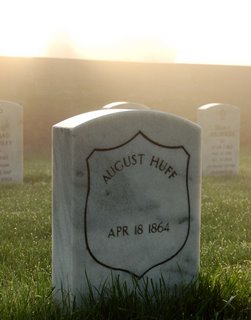Assessments at the time show that New Albany was one of only five shipyards on the Ohio. The following was taken from a memorandum for Lieutenant-General Scott in June 1861 (1)
Building-yards for boats.--The principal boat-building places on the Ohio River are: (1) Pittsburg, Pa.; (2) Wheeling, Va.; (3) Cincinnati, Ohio; (4) Madison, Ind.; (5) New Albany, Ind.; (6) Mound City, Ill.
Regiments were mustered here. Supplies for the Union Army were stored here. The Ohio River was the highway to the South. New Albany was a key stop on that highway and critical to sustaining the Union Army.
The city was also a site designated for the care of wounded soldiers. Eleven hospitals were in operation during the war years. At any given time up to fifteen hundred wounded soldiers were located here during the war. After each major battle in the Western theater of the war, steamships would arrive and disgorge the maimed men from recent battle.
Nearly all the local school buildings were converted to hospitals. Woodward Hall, 128 West Main Street, was also converted to a hospital.

Woodward Hall is one of the few remaining structures in New Albany that served as a hospital.
Following the Battle of Perryville (also know as Chaplin Hills) which took place on October 8th, 1862, New Albany received a large group of wounded. The Ledger reported a listing of soldiers being treated in New Albany hospitals on October 15th(2).
One soldier arriving in October was Private Augustus Huff, from the 42nd Indiana Regiment. Census records from 1860 show that Augustus was a school teacher in Greer Township in Warrick county Indiana. He was 27 years old, his wife was Harriet and he had a six year old son.
Augustus was wounded at Perryville. His regiment was involved in bloody hand to hand combat. Total losses reported for the regiment were 174 killed, wounded and missing - over 1/3 of the regiment of 490 (3). He was sent to New Albany to recuperate. The sight of the quaint river town must have been comforting to him and other wounded compared to the sights and sounds of battle. Our city was a site of refuge.
Private Augustus Huff would recover from these wounds, only to return one final time in 1864 to be buried in the New Albany National Cemetery located at 1943 Ekin Avenue. I recently visited the resting place of Augustus (section B, plot 1486). He earned our thanks and respect.

The cemetery is a hauntingly beautiful place. It was a foggy spring morning when I paid my respects there.

As the weather warms seize the opportunity to take the walk from our riverfront, past Woodward Hall and then to the National Cemetery. It’s a long but rewarding stroll. Many young men took the same route between 1862 and 1865. But they never got to take the walk back home.
(1)Union Correspondence, Orders, And Returns Relating To Operations In Southwestern Virginia, Kentucky, Tennessee, Mississippi, Alabama, West Florida, And Northern Georgia, From January 1, 1861, To June 30, 1865.
(2) New Albany Daily Ledger 15 Oct 1862 p2 c3: Sick and Wounded from Perryville, transcribed at Southern Indiana Genelogical Society website http://www.rootsweb.com/~insigs/
(3) 42nd Indiana Volunteer Infantry website http://www.geocities.com/indiana42nd/
see also website for the New Albany National Cemetery
http://www.cem.va.gov/nchp/newalbany.htm



3 comments:
My grandfather and grandmother both are buried there. He was drafted at the end of WWI went away for training but never saw action.
I suppose I'm lucky he missed the influenza pandemic, eh?
I suppose he did miss the action back home. I've yet to dive into any existing research on the pandemic here in New Albany. I found only one ledger article about some Odd Fellows visting Indy and coming back home with cheese cloth masks that residents were wearing there. The tone the article the set was one of bemusemnt.
Perhaps a detailed analysis of death records would tell the tale? It could have the makings for an interesting post. I do sense a bit of hysteria brewing over our pending bird flu invasion.
Ted, This is a great article. We are currently working on securing funding for an Indiana State Marker to be placed in front of Woodward Hall, 128 West Main Street. The building is now being used as antique mall and a natural market will also be opening soon in the back portion of the building. The third floor walls, ceiling, and floors were the hospital was, remain virtually unchanged since the day it was a civil war hospital.
Post a Comment